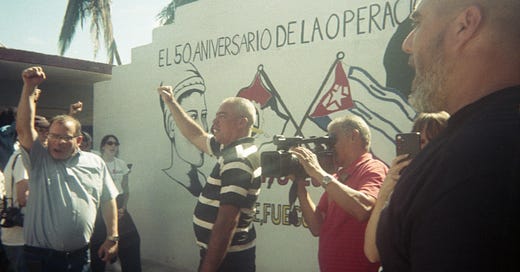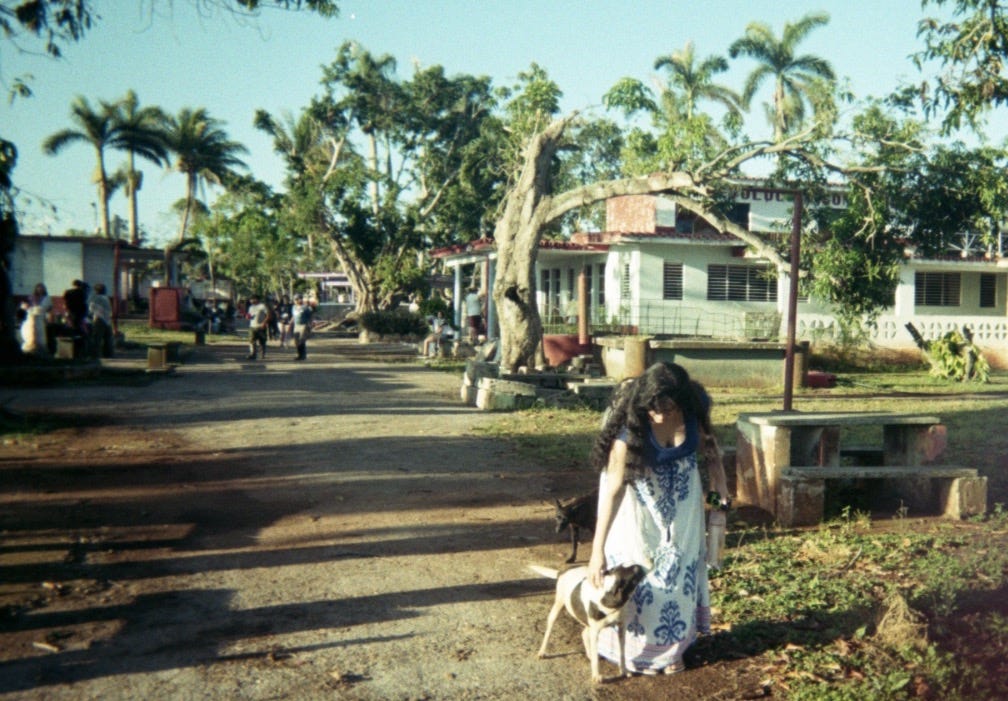It was 4:00 AM on May 1, and I was walking through Havana in the dark. At the edges of the carless street, Cuban citizens stood unarmed in everyday clothing, watching and gently guiding my group to the Plaza de la Revolución where we would watch the May Day parade.
I had never been to a mass public gathering with so little security. As I moved through the streets with the crowd, I didn’t notice armed police, private guards, or plexiglass. Near the square, I passed through a metal detector, and the older woman working it kindly patted me on the back. I made my way to the lawn and sat on the Tennessee flag with my friends, waiting for dawn to break.
As the sun rose to illuminate massive portraits of Fidel Castro and Che Guevara, I turned to see the Cuban president. Miguel Díaz-Canel addressed the crowd from the base of the José Martí memorial, and Raúl Castro appeared at his side. They were a stone’s throw from my seat, dressed in such unremarkable clothing it took me a moment to register their importance. They exchanged smiles and waves with the people as the crowd of thousands, or maybe millions, began to move.
I tried to remember the last time I had seen so many people in the streets. I recalled the George Floyd uprising in Philadelphia, or maybe the night the Eagles won the Super Bowl; but this gathering had none of the anger of a protest or the hedonism of celebrating the birds. There was only the loving, cathartic energy of International Workers Day: a time to remember the struggles of the labor movement, the workers who shaped our world and who continue to carry it forward.
Among the crowd were children and elders; black, white, and indigenous hands lifted banners for every trade union and posters of all the revolutionary heroes. As chants echoed up and down the procession, I moved up to the barrier to get a closer look.
¡Viva Cuba! ¡Abajo el bloqueo! we shouted in call and response. When the people marching realized that my group was from the US, many of them paused to look at us. Older Cubans, in particular, seemed moved by our presence. With tearful eyes, some of them reached over the barrier to squeeze my hand, while others gave me a hug or a kiss. One woman put her hand on my cheek for a long time and openly wept as she thanked me for being there.
One of the central motives for my tapestry work is to capture the experience of solidarity. Living in the US, I’ve mostly encountered this feeling at picket lines and labor rallies, and I’ve described the transformative nature of these collective actions as something spiritual.
If going to a picket line is a spiritual experience, then going to Cuba for May Day is visiting heaven. And when I was touched by those Cuban elders, who still carried with them living memories of the revolution, it felt like meeting someone who witnessed Jesus walk out of the tomb.
Cuba’s revolution persists, but this past year has been one of the most oppressive in history for its economy. This small nation less than 100 miles south of Florida has suffered for decades under the repressive economic blockade, in which the US government will not allow the majority of the world to trade with Cubans for medical supplies, life-saving drugs, food, and many other basic needs. At the same time, Cuba cannot export their own medical innovations to help treat people in the US—such as the Alzheimer’s drug that has slowed and even reversed symptoms of cognitive decline in clinical trials.
These resource shortages were obvious at Campamento Internacional Julio Antonio Mella (CIJAM) where I stayed for the week. We suffered rolling blackouts with no electricity about half of the time. The water frequently ran out, so I couldn’t always get a real shower, and when I did it was a cold sprinkle. We flushed the toilets by pouring buckets of water down them—again, when we had it. Regardless, the Cuban people always made sure we had nourishing food to eat and water and rum to drink. When the lights went out, we still danced.
While the blockade—and the fight to end it—were the primary reasons for my trip, the Cuban government avoided showing us “poverty porn.” They were more inclined to bring our solidarity delegation to witness the programs they were most proud of.
I had the opportunity to visit ELAM (Latin American School of Medicine) where Cuban doctors get a world-class education and then travel around the world to deliver pro-bono medical care. ELAM also welcomes a cohort of international students from every continent to enroll for free, asking only that they take those skills home to better serve their communities. There are no strings attached here: as Fidel Castro said, “internationalism is our way to pay our debts to humanity.”
Next, I went to a nationalized meat processing plant to see how the sausage gets made; literally. In a joint presentation from the HR director and local union leader, I learned how salaries, retirement, paid time off, and disability needs were determined by the people and negotiated with factory workers. They served us nationalized soda in company mugs, which they made a point to wash before returning to us as souvenirs.
Peeking into a metal shop attached to the factory, I saw an impressive example of Cuban ingenuity: a team of repair workers custom-building new parts for industrial machines as they broke down. There were similar stations at factories across the country; part of a broader program to address the need for specialized parts that the Cubans couldn’t import due to the blockade. I began to notice this creative problem-solving everywhere I looked: salsa lids screwed on as makeshift gas caps; tractor engines humming under the hoods of classic cars. I found this repair ethic so striking, and I’ve kept thinking about the quiet resistance of caring for objects in the face of endless consumption and disposal.
At the center of a small, somewhat run-down town, I toured a preschool that resembled expensive Montessori-style programs you would find in the US. This school was free to enroll, with organic food cooked on site and well-paid, highly educated teachers on staff. Children learned and socialized in a play-centered curriculum, with 6 educators assigned to every group of 20 toddlers. The kids had learned to say “good morning” in English, and they had practiced dances and musical performances for the delegation. On the wall was a list of classroom values with “SOLIDARITY” at the top.
Living in the United States comes with this constant simmering thought, at the back of my mind, that I’m waiting for the other shoe to drop. My life here is full of luxury, but underneath every beautiful thing is the understanding that it came to me at another person’s expense.
I can’t eat a piece of fruit without the passive knowledge that the person who picked it for me was exploited. I can’t go out for a meal with friends without noticing the underpaid servers and kitchen staff who don’t get to sit down and eat. I can’t sell my artwork without knowing that a portion of the taxes I pay will go to bomb people in Palestine.
Before I went to Cuba, I spent an amazing month at an artist residency, where I learned a few weeks in that the wealthy founder made his fortune from owning oil fields. I don’t say this as a slight toward this particular residency—I can’t emphasize enough how wonderful and supportive the staff and board were—I only mean to point out that if you look close enough, all private arts funding in the US will eventually trace back to blood money. Just look at the effort it took for organized artists to get the Sackler family name off of dozens of New York galleries and museums. I understand the bitter irony of being a socialist artist in the US economy, where my hands will never be clean.
What kind of spiritual rot must come from this constant, passive participation in exploitation? It seems impossible to stand back and trace how the inherent violence of everyday life must pull on every thread in the social fabric of the US. How can any individual practice love, kindness, and empathy when the conditions of our lives are fundamentally shaped in this mold?
On my last day in Cuba, a worker at the international camp offered me a mango from a tree. While I ate it, I realized that for a rare moment, I wasn’t enjoying this at someone else’s expense. The worker, and the people as a whole, had given it to me of their own choosing. I knew that it was a strain on the Cuban people to host our solidarity delegation—especially in such a critical year of the blockade—but I also knew it was their collective decision. My visit was important enough for the Cubans to share their meager resources, because they understood that I was not just there to extract something: I would, in kind, give back by fighting to end the blockade.
Everywhere I looked, I saw the collective agreements of the Cuban people manifested: the hospitals that never closed, the nourishing organic food, the free schools and universities with guaranteed job placement for graduates. I saw doctors speak about the country’s goal of a 0% maternal and infant mortality rate: a result of the Cuban people deciding that prenatal and neonatal care would be their top priority as a nation. I saw thriving classrooms of happy, well-regulated children, where every baby with a working mother was welcome without the burden of payment.
One day, I walked more than 10 miles around Havana. The stress of the blockade was visible in piles of trash and urban decay throughout the city, but I never saw a person sleeping on the street. Meanwhile, back in the wealthiest country in the world, a growing contingent of my neighbors sleep in tents on the sidewalk.
I wonder how good it would feel to eat mangoes all summer and know that every single person in the country has the chance to eat them too. Imagine going through pregnancy and delivery at a world-class hospital, knowing that no mothers died in childbirth while you get to hold your baby. Imagine sharing a Cuban cigarette with friends, knowing that all of you have free healthcare and a lung cancer vaccine (which many US citizens can’t get without breaking the law.) What would it feel like for our joy to be unapologetic, and shared with everyone?
I believe a kind of happiness exists that is collective: a feeling of not only having your individual needs met, but knowing your entire community is safe and happy too. I think most people in the US have never experienced this happiness. Instead, many of us grapple with a lack of fulfillment in our lives; fumbling around the vague sensation that something is missing. We should feel satisfied as individuals, looking at our lives on paper, but we can feel the shape of the void where our collective happiness should be, even if we don’t have a name for it.
I slept in a small room at CIJAM with 6 other women, and by the end of the week, all of us had gotten our period. It wasn’t fun at the time, but in hindsight, I saw how my body yearns to be part of a collective experience. The tendencies of our ancestors persist in our bodies, reminding us we shouldn’t go through life’s cycles alone, but in lockstep with the people we love.
I’m really glad I read The Dispossessed earlier this year, because I kept returning to it as I learned more about Cuba. Ursula K. Le Guin skillfully captures the complete lack of context that a person from a capitalist world would have for a socialist world, and vice versa. Le Guin says she wrote the book after protesting the US war in Vietnam, inspired by reading anarchist and libertarian-socialist forebears like Peter Kropotkin, Mary Shelley, and Paul Goodman.
The book follows Shevek, born and raised on an anarchist planet (Anarres) as he visits a capitalist planet (Urras) for the first time. Because he has no concept of private property, Shevek doesn’t understand the capacity for selfishness and exploitation in the people he meets. As he moves through Urras, he sees the drive to “possess” as a corrupting force, turning objects and people alike into property, stripping them of humanity.
In one of The Dispossessed’s most moving crescendos, Shevek speaks to a room full of capitalists at a lavish party:
“You are rich, you own. We are poor, we lack. You have, we do not have. Everything is beautiful, here. Only not the faces. On Anarres nothing is beautiful, nothing but the faces. The other faces, the men and women. We have nothing but that, nothing but each other. Here you see the jewels, there you see the eyes. And in the eyes you see the splendor, the splendor of the human spirit. Because our men and women are free, possessing nothing they are free. And you the possessors are possessed. You are all in jail. Each alone, solitary, with a heap of what he owns. You live in prison, die in prison. It is all I can see in your eyes—the wall, the wall!”
Like Urras, the country that produced me is built on exploitation and imperialism, all of it done in the name of material possession. I might have the best intentions to transcend those values myself, but having grown up on this planet, I have little capacity to imagine another social fabric.
Visiting Cuba extended my imagination, as if I had gone on Shevek’s journey. It proved to me that a different world is possible, because I saw that it exists right now. I believe that’s why the Cubans sacrifice so much to bring visitors into their country, because if we’re going to build our own liberation, it helps to witness the living revolution with our own eyes.
What I realized, as I was held and kissed over and over at the May Day parade, was that the Cuban people really believe in my ability to go home to the US and bring an end to the blockade. Not only that—they believe in a revolution for the people of the US, too.
I’ll admit, in the past few years, I have lost a great deal of my optimism about this. I’ve found myself participating in labor organizing and socialist projects out of a sense of duty, rather than feeling real hope in the possibility of victory. l assume my work is part of a long arc, and will contribute to another generation’s freedom one day in the future, but probably not my own. Nihilism permeates the US, and it’s especially powerful in this moment of rising fascism, as we watch our popular movements repeatedly end in crushing defeat. As one delegation organizer remarked: “of course your generation is nihilist! You’ve never seen a win in your whole life.”
Now, I understand that we in the US are possessed by the spirit of capitalism, and this nihilism is a symptom of our possession. If the Cubans still have revolutionary optimism after 60 years of fighting the blockade, then I can take some of that home with me—and that’s what I’ve done.
Now I’m back in the belly of the beast, and the air feels thick with fear and despair, but it doesn’t permeate my skin anymore. I feel like I’ve exorcised something I didn’t even know I was carrying inside. I saw a vision of the future that lives in me like a flame, and I’m going forward with solidarity as my shield.
After all, we didn't talk much in Cuba about Trump, Elon Musk, ChatGPT, or any of the other hot social ills of the moment. The faces have changed, but the enemy of Cuba—of all oppressed people—remains the same. It’s still capitalism. So does the answer to capitalism, which liberated the Cuban people, which can liberate all the rest of us too: it’s still solidarity.
Labor Intensive Recommendations
Countering the Impact of the US Blockade: A Conversation with Llanisca Lugo — Cuba’s International Solidarity Coordinator on the imperial history and purpose of the blockade.
Who’s Afraid of the Little Yellow School Bus? — 1988 documentary on US citizens who went on hunger strike while bringing material aid to Cuba.
Calendario — popular TV show with a scripted, but realistic portrayal of a Cuban middle school.
Blowback, Season 2 — a fascinating history of the Cuban Revolution, and the US effort to crush it, framed in an upbeat, entertaining mode of storytelling.











this was so lovely and put things i’ve been feeling in the pit of my stomach into words.
I loved your words about the felt absence of collective happiness, thank you!